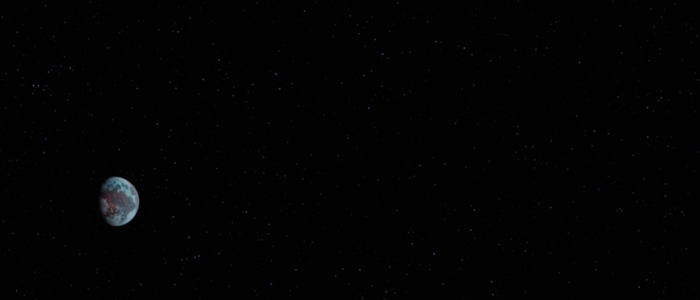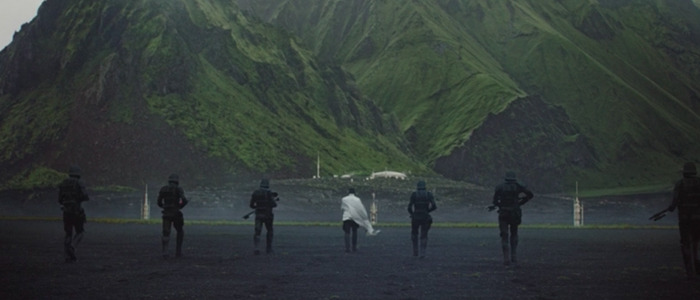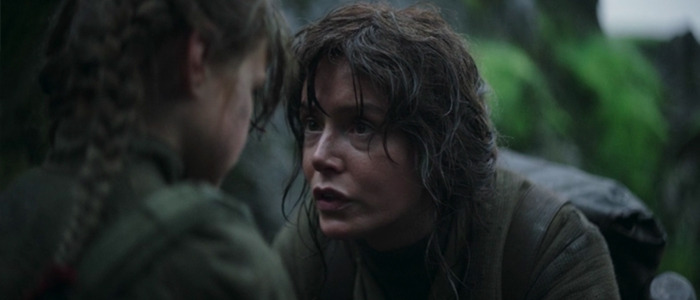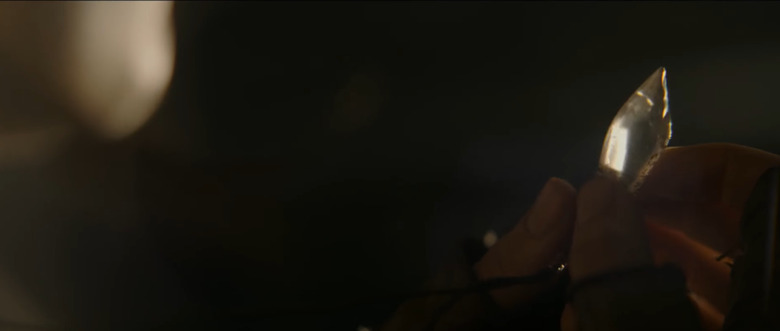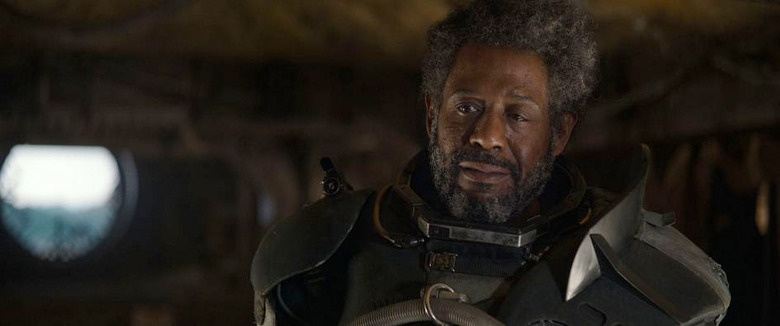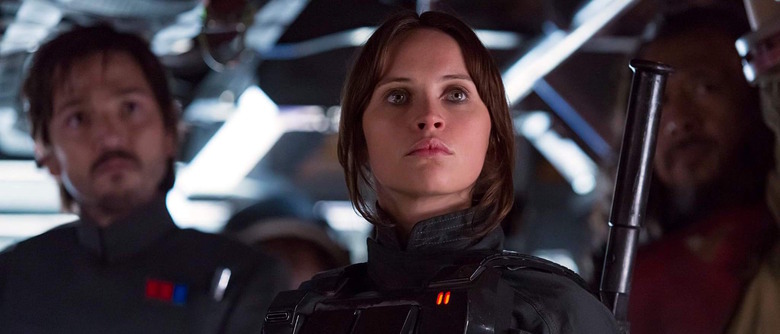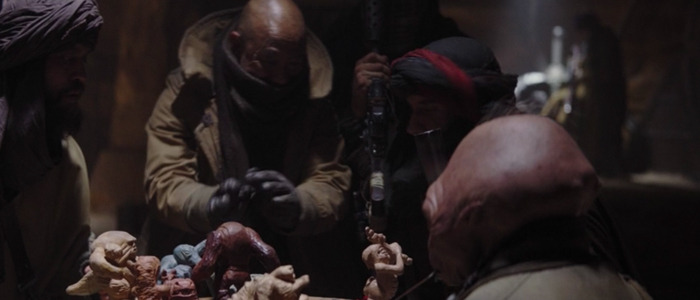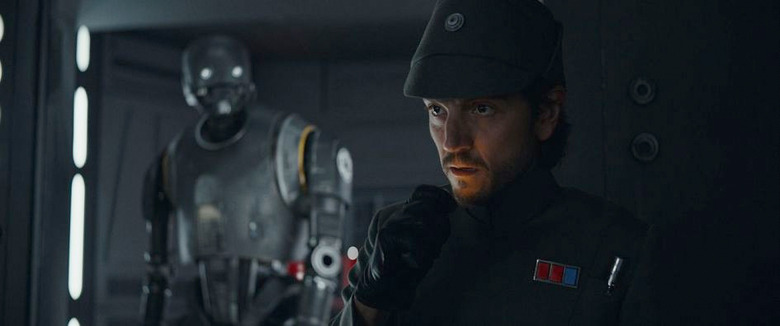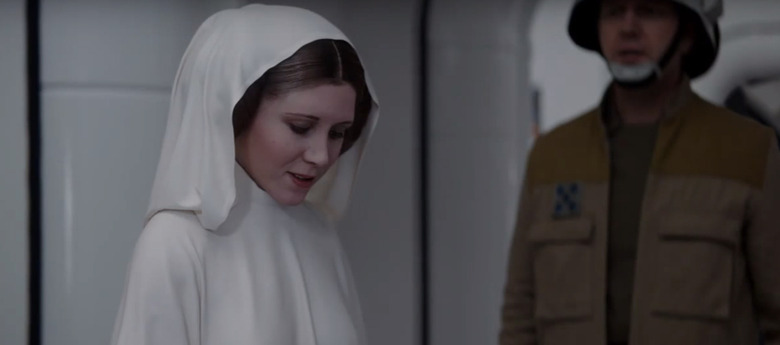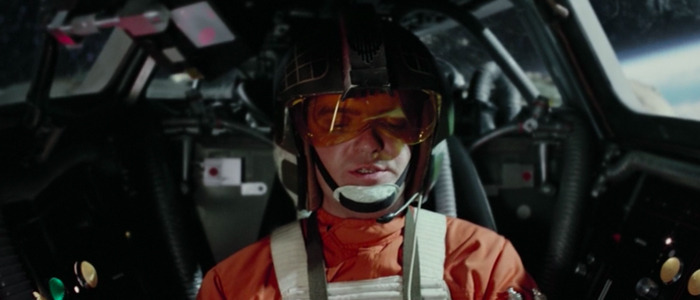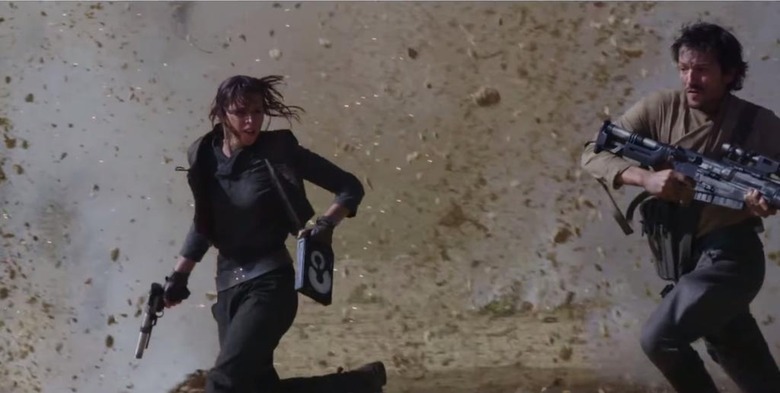20 Things We Learned From The New 'Rogue One: A Star Wars Story' Commentary: 'Inglourious Basterds' References, Alternate Titles, Cassian's Backstory, And More
A long time ago, in this very galaxy, the first live-action Star Wars spin-off movie was released in theaters. Much has been said about the production of Rogue One: A Star Wars Story, but two of the credited writers, Gary Whitta and Chris Weitz, recently participated in a watch party of the film and shared several stories about the making of the movie, including which scenes were reshot late in the game by Tony Gilroy.
Since Rogue One's release, fans have been wondering which specific scenes Tony Gilroy reworked during reshoots, but information like that has been tough to come by. But thanks to Whitta and Weitz, who took part in a watch party earlier this week hosted by IGN, we now know that Cassian Andor's introduction, Jyn Erso's rescue by K-2SO, Saw Gerrera interrogating Bodhi Rook, and Vader and Krennic's discussion on Mustafar were all reworked by Gilroy.
But there was plenty more divulged during the feature-length Q&A, and since there wasn't a proper commentary track on Rogue One's home video release, this is the closest thing we have. Let's dive into some specifics about the rest of the movie, shall we?
No Opening Crawl
Gary Whitta: "The way that the movie opens is really one of the first interesting conversations that Gareth [Edwards] and I had – should there be an opening crawl? I did write one. You'll never see it, but I did. I wrote more than one, back when we were still experimenting with the idea of doing one. But one of the things that we arrived at fairly early on in the process was that it was OK to liberate ourselves from the traditional storytelling language of Star Wars. A lot of the visual tropes – the iris wipes, the opening crawl, things like that – we felt like these standalone movies had more license than the saga films to try to do something a little bit different.
"One of the other conversations we had was, 'Can we do a time jump?' What you see here takes place twenty or so years before the rest of the movie. Star Wars has never done that in the saga films. Once we realized it was OK to do that, we felt a lot more creative freedom to tell the story the way we wanted to tell it."
The Opening Scene References a Quentin Tarantino Classic
Gary Whitta: "Gareth and I talked a lot about how much we love the opening of Inglourious Basterds, if you remember that, with the French farmhouse and Christoph Waltz, the Nazi, comes to interrogate the French farmer. This scene was very much inspired by that. Krennic is basically the Christoph Waltz Nazi coming to interrogate the poor innocents who have to hide this girl. It's one of the more direct cinematic references in the film – I'm surprised more people didn't pick up on it."
Jyn’s Mom Was Originally Going to Be a Jedi
Gary Whitta: "I don't know if that's ever been talked about. The kyber crystal is the last tiny piece of that that's left, but the original idea was that she was a Jedi in hiding. It was one of the first things that got killed, and rightly so. That was kind of a vestige of me as a fanboy wanting to feel like we were checking all the Star Wars boxes. As much as I love the whole military angle of Star Wars, the Rebellion and the Empire, I remember saying to Gareth and to [Lucasfilm executive creative director] Doug Chiang, who was in the room as well, 'This is going to be the very first Star Wars movie that doesn't have a lightsaber in it. How does that make you feel?' And they were like 'It makes us feel great! We want to try these different things.' Of course, it ended up not being true. We had an amazing lightsaber sequence at the end of the movie.
Chris Weitz: "Something interesting that Gareth eventually was keen on was to imagine a world where there was no direct evidence of the Force. So what was the period like before Luke Skywalker came along and met Obi-Wan and there was this new hope. It's a period of possible despair."
Kyber Crystals Originally Played a Larger Role in the Story
Chris Weitz: "[Galen Erso] originally intended to be able to use kyber crystals as a source of energy for the galaxy so there would be no more conflict, and it became weaponized under the [Empire]."
Gary Whitta: "I believe they touch on that in some of the spin-off novels...the idea that kyber crystals were going to power the Death Star was an idea that had been floating around and we crystalized it, forgive the pun, in this movie. But I always loved the idea, because Jedi lightsabers are powered by kyber crystals. So this crystal, which had once been used to power the weapons that protected peace and justice in the galaxy, are now powering the weapon that threatens all of that. I don't know how much of that was really deliberate, but after the fact, it occurred to me that there was a nice bit of poetry in that idea."
Saw Gerrera’s Involvement Was Kiri Hart’s Idea
Gary Whitta: "Gareth was interested in the idea of it not being black and white. That there be shades of grey on both sides...we very quickly honed in on the idea of an extremist, militant rebel. Someone who had legitimately crossed over from being a freedom fighter into just being a terrorist...[We said] 'Who's our Colonel Kurtz? We want the guy at the end of the river, Marlon Brando, Colonel Kurtz, Apocalypse Now type of character who's gone off the deep end.' And [former Lucasfilm Story Group head] Kiri Hart said, 'Well, George actually created a character for The Clone Wars that might fit that really well.'"
The Movie Was Originally Going to Be More of a Slow Burn
Gary Whitta: "In earlier versions, the Death Star is something that Jyn goes and finds. It's much more like Zero Dark Thirty, where she's putting together the clues of bin Laden is in this house in Pakistan – the Empire is building this terrible weapon. It was a battle for Jyn to try to convince the rebels to take it seriously. I think the feeling is that was too much of a slow burn...the idea was to front-load that a lot more and introduce the idea that the Empire was building a planet-killing weapon right up front."
Jedha Eventually Replaced Ord Mantell, and Dantooine Was Once in the Film
Chris Weitz: "For a while, we had Ord Mantell, but then it shifted a bit to the notion of an occupied territory, like in Casablanca."
Gary Whitta: "In the original draft, Jyn went to Ord Mantell, which is a planet that's referenced in The Empire Strikes Back, to find an arms dealer who could help her find Saw Gerrera. There was a bunch of action that happened on Ord Mantell, and then she went to another planet where Saw Gerrera was living on a hidden moon. His splinter group, his militant faction, was on a moon called Yarid, I believe. It was a separate planet, and as the story consolidated down...Jedha filled in for both of those planets."
Chris Weitz: "You do sit in a meeting where they tell you to lose a planet because there's a budget shortfall. It's amazing to think that Star Wars actually has a budget, but it does."
Gary Whitta: "Originally, the rebel base is actually on Dantooine. And you see the rebels evacuate Dantooine and move to Yavin 4. But it didn't really accomplish anything in the story, other than to nod to the Star Wars fans, like, 'Hey, remember Dantooine? There was an evacuated rebel base there? Well, now you get to see them evacuate it.' But it didn't move the story forward and it would have cost a ton of money, so all of the action takes place on Yavin 4."
Jyn Erso’s Backstory Went Through Several Iterations
Chris Weitz: "At one point, Jyn was already a rebel soldier. We toyed with various other possibilities: that she was a deserter, that she was a Rey-like scavenger, but obviously you can't do that when you learn what the other hand of the Star Wars universe is doing."
Grand Moff Tarkin’s Appearance Owes a Debt to an ‘80s Val Kilmer Comedy
Chris Weitz: "This was one of the things John Knoll said they could do, and they sort of built the parachute as they were falling. One interesting thing about it is that obviously you can't scan Peter Cushing, but what John explained to me that they were able to do was take shots from the original Star Wars and unused takes and treat when he would turn in a shot as though it were their version of a 3D scan."
Gary Whitta: "When I first wrote Tarkin into the movie, I wrote him like he was always in shadow. I was trying to give ILM as much wiggle room as possible. He didn't have a lot of dialogue. He wasn't in the movie a lot. They eventually wrote him into the movie way more and gave him much more dialogue because ILM were confident that they could really do it...Peter Cushing was in a movie called Top Secret, the Val Kilmer movie from the 1980s. For that movie, Peter Cushing had to be fitted with a prosthetic, because there's a visual gag where he has a huge eye. So they took a mold of his face, a 3D sculpture of his head. John found that sculpt, sitting on someone's shelf in a prop workshop for decades. He found it, brought it to ILM, 3D scanned it, and that ended up being part of how they recreated Peter Cushing's face for Tarkin."
Bor Gullet Was Originally More Like Hannibal Lecter
Chris Weitz: "The first version of him – my great sadness in life is that on the cutting room floor is a Bor Gullet who's a memory trader. He lives on memories, and he especially delights in traumatic memories. They're more delicious to him. There was, at one point, kind of a space Hannibal Lecter scene where Bor Gullet made Jyn trade her traumatic memories for information that she wanted. That is all I have to say. It makes me sad that's it not in there, and yet I understand."
An Early Version of a Familiar Board Game Makes an Appearance
Gary Whitta: "I don't know how many people ever really pick up on it, but the guys in Saw's hideout are playing an old wooden version of Djarik, the Star Wars chess game. No holographic characters, just like original wooden pieces."
The Inclusion of the Guardians of the Whills
Chris Weitz: "I looked at the original screenplay of Star Wars, which is pretty cuckoo-bananas in terms of ideas. There's some amazing things in it, but it's unfilmable. It's gigantic and kind of shaggy. I was like, 'I'm going to take things from here because there's so many cool things in it.' You can see that happening in other things in other movies in the Star Wars canon. Starkiller Base – originally, Luke was Luke Starkiller. So the Book of the Whills was originally the great Bible tome that all of these movies were adaptations of. I thought, 'That's kind of cool. Whills has a cool sound to it, and I like the idea of these people who are keeping an old faith alive, so we're going to go there.' I believe there's also a notion of the Whills somehow connected to midi-chlorians that I don't fully understand, the metaphysics of it all. But I was just doing some magpie poaching from deep old stuff. Chirrut doesn't say this, but originally the Force was called the 'Force of Others' by Lucas. I had Chirrut often referring to the Force of Others rather than the Force."
Eadu Initially Appeared Earlier in the Movie
Gary Whitta: "They originally went to Eadu very early. [That's where the Empire was] building this laser ray, the dish. Then when it was built, it was shipped to the Death Star construction site, and that was the first hint that Jyn had that the Empire was building something terrible. As the movie got jiggled around and restructured, it got pushed back and became less the place where the dish was built and more the place where they were harvesting and refining the kyber crystals, which are the energy source for the Death Star."
Cassian Andor Used to be a Double Agent
Chris Weitz: "[Cassian] was always meant to be compromised. I think in Gary and my versions, he was severely compromised."
Gary Whitta: "He was a double agent."
Chris Weitz: "For a long time he was working for the Empire. I think this was rationale that I added in, but he had lost people who had been killed by Saw Gerrera. All he wanted from the Empire was the go-ahead and ability to kill Saw Gerrera, rather than Galen Erso. That transmogrified along the lines, post me and Gary, to a rebel intelligence officer who had done terrible things."
Gary Whitta: "He was a rebel soldier who was secretly working for Krennic. But as he grew closer to Jyn and realized that the Empire had built this weapon, he's like, 'I never signed up for this. I never signed up for killing planets.' He has a change of heart and flips to the rebel side. But that's after he's exposed as a spy, and at that point in the third act, he kind of has to win Jyn's trust back. That was all fun and interesting, I think they actually shot some of that stuff early on, but [the final] version ended up being more nuanced and more interesting."
Rogue One Was Not Always the Title
Chris Weitz: "There was one point where we were kicking around titles for this. Rogue One was a good choice eventually, but one of them was Dark Times."
Gary Whitta: "We had a lot. At one point, John Schwartz, who is one of the creative executives of the film, had a list, and we all voted on the ones we liked. I contributed two: one was Rogue One, [and the other was] Shadow of the Death Star, all these fancy titles. I went back and looked at all the previous films – and this continues to be true even with the sequel trilogy now being completed – the titles of Star Wars saga films are always either three or four words long. They just all are. So it occurred to me that one of the ways we could differentiate this movie from the rest was if we had a title that was only one or two words long. So Star Wars: Rebellion, Star Wars: Rogue One, things like that. I wanted to do a title that was shorter so even from the title of the movie, you know this is something that doesn't necessarily conform to the unwritten rules of the saga films."
Princess Leia Nearly Showed Up Earlier in the Film
Chris Weitz: "Briefly, we toyed with – or maybe it was just me – a Leia appearance [in the Yavin 4 council scene]. She is referred to when Bail Organa chats with Mon Mothma, but it's best I think for Jyn to give the rousing speech here."
The Filmmakers Knew the Characters Had to Die
Gary Whitta: "We went back and looked at the ending of Gladiator when Maximus dies. The idea that you can have a righteous death, you can be triumphant even in death because you've accomplished your greater goal, was something that was really important to us. But we thought Disney would never let us do it. We'll fall in love with killing all the characters, Disney won't let us do it, and we'll have our hearts broken. So we didn't follow through on our initial creative instinct, and I wish we had because it turns out that Disney and Kathy and all those guys were fully supportive of it. When I left the movie and Chris came on, the first thing he said was, 'I feel like these characters need to die' and Gareth was like, 'Oh yes! I'm so glad you said because that's what Gary and I talked about.' We got there in the end, but I guess the moral is, trust your instincts and write the version of the movie that you believe, not the version you believe people will say yes to...In my version, K-2 always died, but Jyn and the others survived. I think that would have been a far inferior version of the film. I'm so glad that Chris came along and had that same instinct to kill the characters because it ended up, I think, being some of the most powerful stuff in the film."
Why Wedge Antilles Wasn’t Among the X-Wing Pilots in the Battle of Scarif
Gary Whitta: "It would have been nice to put Wedge here. But there's a line in A New Hope when Wedge says, 'Look at the size of that thing!' and it's very clear as he's seeing the Death Star that he's seeing it for the first time. Red Leader and the other pilots, they're like, 'Whatever.' They saw this thing yesterday, so it's less impressive to them."
Alternate Takes From A New Hope Were Included
Gary Whitta: "Those aren't actually shots from A New Hope. Those are alternate takes that never got used. But they found them, digitally cleaned them up, matched them with the extra footage, and even tracked down the original actors and had them re-record new dialogue."
Why Footage From the Trailers Didn’t Make the Final Cut
Chris Weitz: "I've heard it on good authority that the TIE Fighter hoving into view right in front of Jyn was actually never intended to be used. It was a trailer-specific moment, even though it's pretty awesome. I don't know how she would have gotten out of that one. Originally K-2 died on the beach. I'm not always sure why these things happen. All I can say is that while you're cutting these things together during production and in post, all kinds of narrative necessities arise. 'Oh, we can't do that part anymore if they're going to have to get to the master switch.' So eventually they get elided. But nevertheless, some of these shots are so cool that they're perfect for trailers."
Gary Whitta: "I can speak to it a little bit. My understanding is, when I originally wrote the battle, there were two separate facilities on Scarif, on that stretch of beach. There was a building where the plans were held in a vault, and then there was a separate building which was a communications tower, and they were separated by a stretch of beach. So part of the mission was to liberate the plans from the vault and then get them across the beach to the tower where they could transmit them. So when you see those scenes in the trailer of Jyn, we actually shot those scenes of Jyn running with the Death Star plans in her hand across the beach. That's them trying to get from the building where they stole the plans to the comms tower where they could transmit them. I think as they looked at what they had, there were too many moving parts. They wanted to simplify it, and I think the solution, quite an elegant solution, was just to put both the vault and the tower in the same complex."
***
Rogue One: A Star Wars Story is currently streaming on Disney+.

